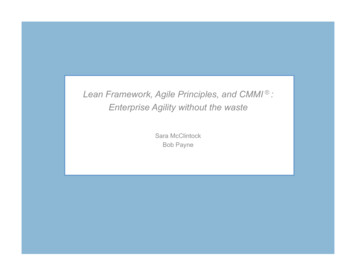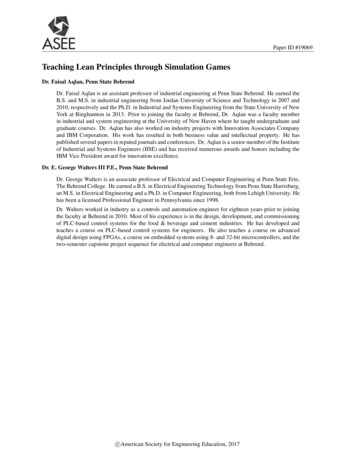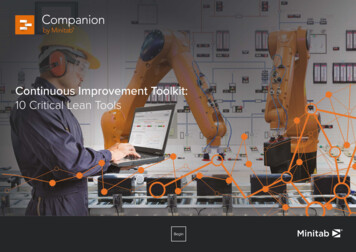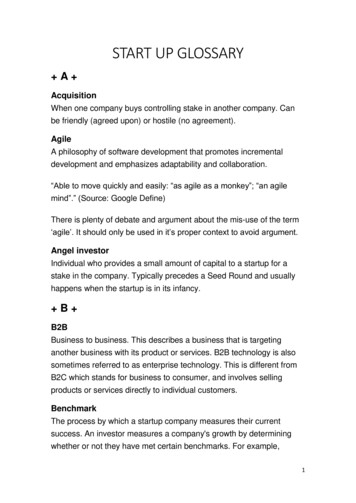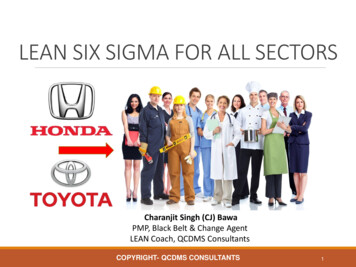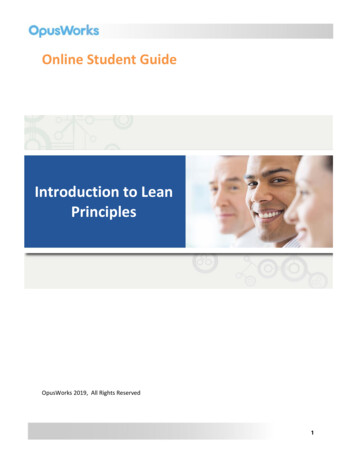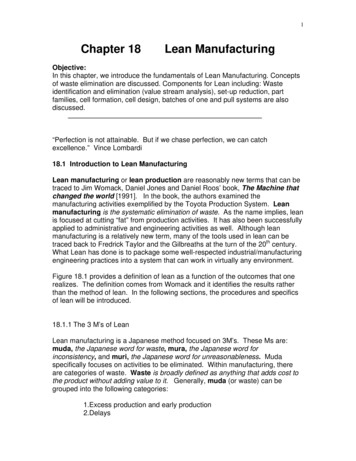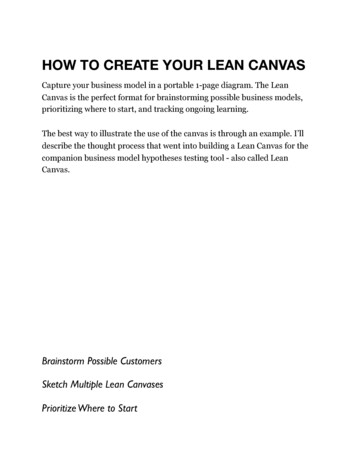
Transcription
THE TEN COMMANDMENTSOF LEAN SIX SIGMA
PRAISE FOR THE TEN COMMANDMENTS OF LEAN SIX SIGMA:I am delighted to finally see a well-structured Lean SixSigma book that focuses on the behavioural and cultural necessities for successful Lean Six Sigma programsrather than on the use of tools and techniques. Theauthors have drawn upon their vast experiences working with Operational Excellence programs acrossdiverse industries to bring us the absolute must-havecomponents for success.— John Dennis, Chairman, International Lean Six SigmaInstitute, UKI would recommend this book as it captures the essenceof results-based references to the tools and conceptsrequired in a structured way to achieve the process ofimplementing the leverage of Lean Six Sigma to maximise efficiencies and maintain the managerial process.Every business needs to revisit and discover how topropel your organisation to new levels of competitivesuccess this book will support and guide you.— Michael Mitchell, Managing Director, Bespoke ClinicalCare Ltd, UKThe Ten Commandments of Lean Six Sigma bringstogether the leading authors of our time and presentsa unique guide for any leadership team as they embarkon their LSS journey. The final chapter on the future ofLSS is a must read for established LSS practitioners.— Stephen G Anthony, Master Black Belt and CEO of theInstitute of Six Sigma Professionals, Wales, UKIn today’s competitive world, any firm needs to beconscious of quality, cost and timely delivery. Toachieve this, the book The Ten Commandments ofLean Six Sigma will be a very useful guide for practitioners. The book addresses all that is required by the
practitioners to implement LSS in their respective organizations. This book aims to transfer the knowledgethat is available with the academic world for its practical application in the competitive business world.— S Navaneetha Krishnan, Senior Deputy GeneralManager at Warship Design Centre, Larsen & Toubro andCommander (Retd), Indian NavyThe authors’ experience with training in both academicand industrial settings are evident, as the methods prescribed for preparing individuals for LSS execution areapplicable to both scenarios and will likewise preparethe reader for either. They understand that it is notenough to be technically proficient, in order to be asuccessful LSS practitioner, and they offer solid advicein the critically required soft skills, as well. This bookwill help any organization preparing to embark uponthe continuous improvement journey.— David W. Hoffa, PhD, ASQ CSSBB, External ProcessEngineering Manager, Johnson & JohnsonThis book is definitely a new piece of art in Lean SixSigma literature! The authors present an exceptionalcombination of rigorous literature review and solidpragmatic recommendations addressing critical topicsin Lean Six Sigma from top to bottom. Content isbrilliantly presented in an understandable languageand the sequencing of commandments flows smoothlyand logically in a way that you just can’t stop reading.— Marcelo Machado Fernandes, PhD, ASQ CertifiedMaster Black Belt, Lean Six Sigma Consultant at FCV andSETA, Consultant at Minitab LLC, Founder of MFTreinamentos (MF Operational Excellence), Brazil
This page intentionally left blank
THE TEN COMMANDMENTSOF LEAN SIX SIGMAA Guide for PractitionersJIJU ANTONYHeriot Watt University, UKVIJAYA SUNDER M.The World Bank Group, IndiaCHAD LAUXPurdue University, USAELIZABETH CUDNEYMissouri University of Science andTechnology, USAUnited Kingdom – North America – JapanIndia – Malaysia – China
Emerald Publishing LimitedHoward House, Wagon Lane, Bingley BD16 1WA, UKFirst edition 2020Copyright 2020 Emerald Publishing LimitedReprints and permissions serviceContact: permissions@emeraldinsight.comNo part of this book may be reproduced, stored in a retrievalsystem, transmitted in any form or by any means electronic,mechanical, photocopying, recording or otherwise withouteither the prior written permission of the publisher or a licencepermitting restricted copying issued in the UK by The CopyrightLicensing Agency and in the USA by The Copyright ClearanceCenter. Any opinions expressed in the chapters are those ofthe authors. Whilst Emerald makes every effort to ensure thequality and accuracy of its content, Emerald makes norepresentation implied or otherwise, as to the chapters’suitability and application and disclaims any warranties,express or implied, to their use.British Library Cataloguing in Publication DataA catalogue record for this book is available from the British LibraryISBN: 978-1-78973-690-8 (Print)ISBN: 978-1-78973-687-8 (Online)ISBN: 978-1-78973-689-2 (Epub)
Dedicated to our parents and families
This page intentionally left blank
TABLE OF CONTENTSList of FiguresxiiiList of TablesxvAbout the AuthorsxviiPrefacexxixxiiiAcknowledgements1. Introduction to Lean Six Sigma and Ten Commandments1.1 Introduction to Lean and Six Sigma1.2 Why Is the Integration of Lean and Six Sigma a BetterApproach for Problem-solving?1.3 LSS Methodology: An Overview1.4 An Overview of the Ten Commandments of LSS1.5 Summary2. Alignment of Lean Six Sigma with Organisational Strategy2.12.22.32.42.5IntroductionNeed for Aligning LSS with Organisational StrategyWhat Is Hoshin Kanri?Applying Hoshin Kanri for Selection of LSS ProjectsConcluding Guidelines3. Lean Six Sigma Project Selection and racteristics of Good and Bad LSS ProjectsHow to Select and Prioritise Projects?Who Is Responsible for Project Selection?Management of Project ReviewsCommon Reasons for Failure of LSS Projects in OrganisationsSummary4. Selecting Top Talent for Execution of Projects4.1 Introductionix113568991011131517171819222325272929
Table of Contentsx4.24.34.44.5Identifying Top TalentTraits of High Potential EmployeesHigh Potentials in Lean and Six SigmaDeveloping an Agile Program for Lean Six SigmaHiPo Selection4.6 LSS HiPo Selection Process4.7 Developing an Agile Program for HiPo in LSS4.8 Career Progression and Leadership Positions5. Leadership for Lean Six Sigma ic Significance of LSS LeadershipEssential Leadership Skills for Successful Deployment of LSSLeadership Behaviours for LSS TransformationLeadership Characteristics for Lean Six SigmaLeadership Styles for Lean Six SigmaSummary6. Effective Training and Design of Curriculum for DifferentLSS Roles6.16.26.36.46.56.66.76.86.9IntroductionLean Six Sigma CurriculumLSS Teaching and TrainingCourse PreparationSoft Skills TrainingCurriculum DevelopmentCurriculum AssessmentChallenges, Lesson Learnt and SustainabilitySummary7. Development of Rewards and Recognitions for LSS7.17.27.37.4IntroductionWhy Rewards and Recognitions?Types of Reward and Recognition Systems Effective for LSSRewards and Recognitions – A Management Strategy forEffective Change Management7.5 Conclusions8. Lean Six Sigma Sustainability8.1 Introduction8.2 Ten Critical Challenges in Sustaining LSS Implementations8.3 A Few Strategies to Overcome the Challenges of LSS’Sustainability8.4 262646870717373747679808383848789
Table of Contents9. Linking Lean Six Sigma with Innovation andOrganisational Learning9.19.29.39.4IntroductionLinking LSS with InnovationLinking LSS with Organisational LearningSummary10. Linking Lean Six Sigma with Green and EnvironmentalSustainability10.1 Introduction10.2 Green Lean Six Sigma and Environmental Sustainability10.3 Challenges and the Emerging Trend of Integration ofGreen Lean Six Sigma10.4 Conclusions11. Beyond LSS: Emerging Themes of Lean Six Sigma11.111.211.311.4IntroductionIntegration of LSS with Robotic Process AutomationIntegration of LSS with Big DataLSS within a Holistic Improvement Strategy andMethodology11.5 Integration of LSS with Statistical Engineering11.6 LSS in Public Sector Organisations11.7 Integration of LSS into Higher Educational 13114116References117Index129
This page intentionally left blank
LIST OF FIGURESFigure 2.1 Roadmap to Create Hoshin Kanri X-matrix.14Figure 3.1 Effort–Impact Matrix for Project Selection.20Figure 4.1 Levels in Lean Six Sigma.37Figure 4.2 360-Degree Feedback Mechanism.40Figure 4.3 Phase-gate Monitoring.40Figure 6.1 Backward Design Process.65xiii
This page intentionally left blank
LIST OF TABLESTable 3.1Criteria for Project Selection and Respective Scores. 21Table 3.2Criteria and Score for Project Selection.Table 10.1 Linking Lean Green – Similarity in Views.xv22103
This page intentionally left blank
ABOUT THE AUTHORSJiju Antony is recognised worldwide as a leader in Lean Six Sigmamethodology for achieving and sustaining process excellence. Heis a Professor of Quality Management and Director of ProcessImprovement in the School of Social Sciences at Heriot-WattUniversity, Edinburgh, Scotland. Professor Antony has beenresearching on the topic of Six Sigma and Lean Six Sigma since2001 and published over 200 journal, conference and whitepapers as well as four books on these two topics alone with over15,000 citations and H-index of 71; which is considered to be thehighest in the world on Operational Excellence topic. He is thefounder of the International Conference on Six Sigma and is alsothe founder of the International Conference on Lean Six Sigma forHigher Education. He is the Editor-in-chief of the InternationalJournal of Lean Six Sigma, Associate Editor of the Total QualityManagement & Business Excellence journal and Associate Editorof TQM Journal.xvii
xviiiAbout the AuthorsVijaya Sunder M. is currently Head of Business Process Excellenceat the World Bank Group, Chennai. He is a Lean Six Sigma MasterBlack Belt, PMP, ISO 9001:2015 Quality Lead Auditor, and LeanFacilitator. He holds his PhD in Operational Excellence from theIndian Institute of Technology Madras, a distinction holder in MBAfrom Sri Sathya Sai Institute of Higher Learning and gold medalistin Bachelor of Engineering from Anna University, India. He has ledand mentored various operational excellence programs that helpedimprove the customer experience, employee satisfaction, eliminateprocess defects, increase productivity and reduce costs acrossmultinational organisations including World Bank, Barclays,American Express and Citi. He has trained more than 1,500 people(as on July 2018), in Lean Six Sigma, Agile, process automations,strategy and leadership for establishing process improvementcapability in firms. Alongside corporate job, he practices teachingfor MBA students as a visiting faculty at various business schoolsand has published research papers in several reputed internationaljournals and magazines.
About the AuthorsxixChad M. Laux is currently Associate Professor of Computer &Information Technology at Purdue University, West Lafayette, andhas developed a concentrated area in Lean Six Sigma where heteaches Lean Six Sigma Systems at the Undergraduate and Graduatelevels in Computer & Information Technology. His teachingattracts a wide variety of student majors including Computer &Information Technology, Industrial Engineering Technology,Supply Chain Management Technology, and Healthcare Policy andManagement. During his 13 years in the industry, he servedprimarily in Tier One organisations and managed Quality Engineering, Industrial Engineering and Product Design functions.During that time, Chad received multiple Six Sigma Black Beltcertifications and conducted multiple continuous improvementprojects.
xxAbout the AuthorsElizabeth Cudney is currently Associate Professor in the Engineering Management and Systems Engineering Department at MissouriUniversity of Science and Technology. She received her BS inIndustrial Engineering from North Carolina State University,Master of Engineering in Mechanical Engineering and MBA fromthe University of Hartford, and doctorate in Engineering Management from the University of Missouri – Rolla. In 2018, she receivedthe ASQ Crosby Medal for her book on Design for Six Sigma. Shereceived the 2018 IISE Fellow Award. She also received the 2017Yoshio Kondo Academic Research Prize from the InternationalAcademy for Quality for sustained performance in exceptionalpublished works. She received the 2008 ASQ A.V. FeigenbaumMedal and the 2006 SME Outstanding Young ManufacturingEngineering Award. She has published 9 books and over 85 journalpapers. Dr Cudney is a certified Lean Six Sigma Master Black Belt.
PREFACELean Six Sigma (LSS) is a powerful Operational Excellence (OE)methodology for making critical business processes more efficientand effective by reducing waste and variation, which results inenhanced customer satisfaction, improved productivity and reducedoperational costs. While the success stories speak for themselves,there were critics who have highlighted the failure of LSS due tovarious reasons. As more and more organisations are joining thejourney of LSS, the failure of this initiative is also surfacing fromvarious organisations. Though there is significant research evidenceavailable on critical success and failure factors of LSS implementation in organisations, these aspects have been merelyrestricted to the tactical side of LSS.Though organisations initially realised LSS as an effective toolkitwith a collection of problem-solving tools for process improvements, later the evolution of understanding clarified LSS as anorganisation strategy and a leadership approach for imbibing thequality culture in organisations. Although a plethora of articles onLean Six Sigma have been published in a wide variety of sources,the authors have observed that no general guidelines have beenprovided to organisations for implementing and sustaining thispowerful business process improvement strategy.This book presents Ten Commandments of Lean Six Sigmafrom the perspective of practitioners, researchers and academicswho have been involved in the training, teaching, research andconsultancy on various topics of quality and continuous improvement such as Lean, Six Sigma and LSS. These commandmentscan serve as a practical guide for senior managers and executivesfor achieving operational and service excellence in variousmanufacturing, service and public sector organisations despite theirxxi
xxiiPrefacesize. We hope that business executives and senior managers as wellas a number of practitioners and consultants will find this bookuseful in conveying the key elements to launch and sustain an OEjourney in any organisational setting.The book is divided into 11 chapters. The first chapter is anintroduction to Lean Six Sigma (LSS) as a powerful OperationalExcellence (OE) methodology for achieving both efficiency andeffectiveness in business processes. The remaining chapters are theTen Commandments of Lean Six Sigma which include some ofthe most important factors which need to be taken into account forthe successful journey of LSS. Some chapters include the latesttrends or emerging themes which will be essential for the furthergrowth of OE in the next 25 years or so. We truly hope this bookinspires many senior managers in organisations to get into the habitof embracing OE strategy for creating and sustaining competitiveadvantage. We are indebted to many contributors and leadingexperts for the development of OE strategy and its associated toolsand techniques applied in industry today, especially Mr. TaiichiOhno as the father of the Toyota Production System, ProfessorJames Womack, Professor Daniel Jones and Professor Daniel Roosfor their contributions to the Lean Production System in creatingvalue for customers through continuous improvement, Dr. MikelHarry who has done some pioneering work in Motorola for thedevelopment of Six Sigma as a business process improvementstrategy and methodology and, finally, Mr. Michael George for hisunique contribution to the integration of the most two powerful OEmethodologies such as Lean and Six Sigma.Jiju Antony, Vijaya Sunder M., Chad Lauxand Elizabeth Cudney
ACKNOWLEDGEMENTSThis book was conceived further to publication from an articleentitled Ten Commandments of Lean Six Sigma: a practitioner’sperspective that appeared in the International Journal of Productivity and Performance Management. We are deeply indebted to anumber of people who, in essence, have made this book what it istoday. First, and foremost, we would like to thank a number ofcolleagues in industry for their constant encouragement in writingup this book. We would like to express our deepest appreciation toKaty Mathers and Pete Baker at Emerald Publishers for their support and forbearance during the course of the project. Finally, wewould like to express our sincere thanks to our parents and familyfor their encouragement and patience as the book stole countlesshours away from family activities.xxiii
This page intentionally left blank
1INTRODUCTION TO LEAN SIXSIGMA AND TENCOMMANDMENTS1.1 INTRODUCTION TO LEAN AND SIX SIGMAWhile a number of continuous improvement (CI) methodologiesexist in the literature, Lean and Sigma have been used for over30 years in several organisations, proving to be most powerful andrenowned. The development of an effective CI strategy is a keyfactor for long-term success in modern organisations. Over the last15 years, Lean Six Sigma (LSS) has become one of the most popularand proven business process improvement or CI methodologiesorganisations have witnessed in the past. This chapter provides aquick overview of Lean, followed by Six Sigma and its integrationcalled LSS. It also outlines the importance of the Ten Commandments of LSS which are primarily aimed for business leaders andsenior executives in organisations. The Ten Commandments of LSSare based on several years’ experience of four co-authors who act asLSS Master Black Belts, practitioners, trainers and researchers onvarious topics of Lean, Six Sigma and general quality management/CI topics.Lean has had a tangential development history compared to SixSigma. Much of the Lean Production System (LPS) is based on theToyota Production System (TPS) (Womack, Jones, & Roos, 2007).1
2The Ten Commandments of Lean Six SigmaTPS has roots that go back to Henry Ford’s development of theassembly line and Frederick Taylor’s work on scientific management(Womack & Jones, 2003). The concept of LPS involves determiningthe value of any process in the eyes of customers by distinguishingvalue-added activities or steps from non-value-added activities orsteps and eliminating waste. Krafcik (1988) is generally credited withthe first use of the term ‘Lean Production System’. Lean began with amanufacturing emphasis and was referred to as lean manufacturingfor many years. Gradually, organisations learnt that the same principles of push vs pull system, identification and reduction or evenelimination of waste and standardisation of processes/procedures,can also be applied to non-manufacturing settings.While it is impossible to set a definite date for the beginning ofSix Sigma, around the mid-1980s, Bill Smith and his colleagues inMotorola began improvement projects that looked similar to TotalQuality Management (TQM). Motorola was facing fierce and stiffcompetition with its competitors in the pager market and needed toimprove quality as well as reduce operational costs to stay inbusiness. Bob Galvin, the CEO of Motorola, along with his colleagues decided to invest in Six Sigma and adopted it as a corestrategy at the operational level for delivering quality at low costs.Six Sigma provided an overall roadmap for solving complexproblems with unknown solutions (Snee & Hoerl, 2005). Motorolaachieved tangible and measurable results to the bottom line, andother organisations began to take notice of Motorola’s successincluding Honeywell (previously Allied Signal). In 1995, JackWelch who was the CEO of GE (General Electric) stated that thecompany would incorporate Six Sigma to reduce defects andoperational costs. Consequently, this initiative became well recognised, appearing on the front pages of well-known newspapers.Welch (2001) told Wall Street analysts that Six Sigma would bethe biggest initiative ever launched by GE and that it would be hisbiggest priority for the next five years. Before official resultsemerged for the company, GE stock began to rise, and many othercompanies started looking more closely at Six Sigma. Based on GECapital’s success, other financial institutions began Six Sigma initiatives. One of the most successful has been by Bank of America,which has publishing savings in the billions of dollars annually
Introduction to Lean Six Sigma and Ten Commandments3(Sunder, Ganesh, & Marathe, 2019). Similarly, CommonwealthHealth Corporation launched the first major Six Sigma deploymentin healthcare in the late 1990s and produced millions of dollars ofsavings in the radiology department alone within a year (Snee &Hoerl, 2005). In the late 1990s and early 2000s, a large number oforganisations, in diverse industries, launched Six Sigma initiatives,including DuPont, Dow Chemical, 3M, Ford and AmericanExpress, to name just a few. The US military began major investments in Six Sigma at this time as well. Overseas, companies inEurope and Asia began to implement Six Sigma to varying degrees,particularly Korean companies such as Samsung (Snee & Hoerl,2003).1.2 WHY IS THE INTEGRATION OF LEAN AND SIXSIGMA A BETTER APPROACH FOR PROBLEM-SOLVING?Although both Lean and Six Sigma had produced immense andsignificant benefits to many organisations, they do have some limitations. George (2002) has successfully integrated these twopowerful methodologies for business process improvement andclaimed that the integrated approach is superior to using Lean orSix Sigma on its own. His view was that Lean is not well suited toresolving complex problems that require intensive data analysis andadvanced statistical tools and techniques. Those implementing SixSigma found that not every problem needed several months of datacollection to resolve. Quality professionals found that Lean principles and tools could be primarily applied with minimal datacollection and achieve immediate results.In many Lean applications, the solution to the problem is knownto the team and all that is needed is a methodology and a set oftools to implement the known solution. Lean is primarily focusedon the flow of information and material between processes.Therefore, if the root cause of the problem is a flow issue, Lean islikely to work well. However, if the problem involves understanding the most critical process parameters which influence the outputand if the output varies significantly due to a number of factors, thiswill be a great candidate for the Six Sigma methodology.
4The Ten Commandments of Lean Six SigmaDeploying Six Sigma in isolation cannot remove all types ofwaste from the business process, and deploying Lean in isolationcannot bring a process into a state of statistical control and removevariation from the process (Corbett, 2011). Therefore, some companies have decided to merge both methodologies, rather thanimplement them in isolation to come up with a more powerfulstrategy for process excellence and optimising processes (Bhuiyan,Baghel, & Wilson, 2006). Bertel (2003) highlighted that using eitherone of the methodologies alone has limitations: Six Sigma willeliminate defects in processes, but it will not address the question ofhow to optimise process flow. In contrast, Lean principles are nothelpful in achieving high-capability and high-stability processes.According to Antony, Snee, & Hoerl (2017), the integrationof Lean and Six Sigma in organisations increases efficiency andeffectiveness, helping them to achieve superior performance fastercompared to the implementation of each approach in isolation. LeanSix Sigma (LSS) is a business process improvement methodology thatfocuses on process performance, resulting in enhanced customersatisfaction and improved bottom-line results in hard-cash savings.LSS provides the concepts, methods, tools and techniques for processmanagement. It is an effective leadership development tool as itprepares leaders for their role in managing change. A review of over20 case studies of LSS has shown the following benefits of LSS: Increased profits and financial savings Increased customer satisfaction Reduced operational cost Reduced cycle time Improved key performance metrics Reduced defects in processes Reduced machine breakdown time Reduced inventory Improved throughput yield Increased production capacity
Introduction to Lean Six Sigma and Ten Commandments51.3 LSS METHODOLOGY: AN OVERVIEWThe LSS methodology is used for solving existing problems inany process when the solution is unknown or when a confirmation is needed to validate the root cause of the problem.LSS experts follow a stringent and disciplined methodologycalled Define-Measure-Analyse-Improve-Control (DMAIC), andthis section presents a brief overview of this powerfulmethodology.Define Phase: In this phase, we usually define the problem or theopportunity for improvement. This is a very important phase ofproblem-solving. If we do not define and formulate the problemcorrectly upfront, one may struggle in the development of appropriate solution at a later stage. The common tools used in thisphase are Voice of the Customer (VOC) analysis, Supplier–Input–Process–Output–Customer (SIPOC), Process Mapping, ProjectCharter, etc.Measure Phase: In this phase, we need to measure the baselineperformance of the process, and this measurement is used as ayardstick for further improvement. The common tools used in thisphase are Critical-to-Quality drill-down tree, Measurement SystemAnalysis (MSA), Run Charts or Control Charts, Process CapabilityAnalysis, etc.Analyse Phase: In this phase, we need to understand thepotential/root causes of the problem due to excessive process variability. Typical tools used in this phase include Hypothesis Testing,Pareto Chart, Scatter Diagram, Correlation Analysis, Cause andEffect Analysis, Histogram, Root Cause Analysis, etc.Improve Phase: In this phase, the process performance will beimproved through the development of potential solutions which caneliminate the root causes of the problem at hand. One may generatepotential solutions, select and prioritise them, perform risk assessment, pilot the solution for its effectiveness and finally evaluate thebenefits. Typical tools used in this phase include PrioritisationMatrix, Design of Experiments, Single Minute Exchange ofDies, etc.Control Phase: The goal of the control step is to sustain the gainsby standardising the work methods or processes, anticipating future
6The Ten Commandments of Lean Six Sigmaimprovements and capturing and documenting the key lessonslearnt from the project and exploring the opportunities of transferring the knowledge to other operations in the business. Typicaltools used in this phase include Standard Operating Procedures(SOP), Visual Management, Control Charts, Poka-Yoke (MistakeProofing), etc.1.4 AN OVERVIEW OF THE TEN COMMANDMENTSOF LSSIn this section, the authors provide an outline of the Ten Commandments of LSS. These are the essential ingredients to beunderstood by senior executives and business leaders in anyorganisational setting for the successful deployment of LSS. Eachchapter in the book will be focussing on these vital points indetail.1. Alignment of Lean Six Sigma with organisational strategy: Theleaders and business executives should ensure that the LSS is anintegral part of the organisational strategy and ensure thatselection of projects is aligned with the strategic goals of thebusiness.2. Lean Six Sigma project selection and prioritisation: For thesuccessful journey of LSS and its sustainability, it is essentialthat projects must be identified and prioritised for theirexecution by project teams.3. Selecting the top talent for the execution of projects: In orderto gain momentum for the use of LSS in any organisation, itis critical that one should select the top talented people forthe execution of projects and a set of skills should bedeveloped for project leaders at Green Belt and Black Beltlevels.4. Leadership for LSS: Leadership has proved to be one of themost critical success factors of LSS (Laureani & Antony, 2018).Deming suggested that quality excellence could not be achievedin organisations without educating leadership on the
Introduction to Lean Six Sigma and Ten Commandments7importance of quality, and the same analogy could be appliedto process excellence.5. Effective training and design of curriculum for different LSSroles: Training should be imparted to all those concernedsuch as LSS project champions and LSS project leader (BlackBelts, Green Belts, etc). An awareness of LSS through LSSexecutive workshops is highly desirable for all senior managers in the organisation to understand their level ofinvolvement and commitment throughout the implementationand sustainability of LSS.6. Development of reward and recognition system: A reward andrecognition system should be an inherent part of any changemanagement initiative. Leaders in the organisation shouldintroduce some form of incentive or reward and recognitionsystem for sustainability of the LSS initiative.7. Lean Six Sigma sustainability: Sustainability of LSS is one ofthe biggest challenges for all organisations today. The authorssuggest the importance of sustainability in the roadmap ofsuccessful LSS deployment and people should be aware of thefactors which influence the sustainability of the LSS initiative.8. Linking LSS with organisational learning and innovation: LSSis an enabler of individual learning as it promotes activitybased learning though project management and structuredproblem-solving. Anand, Ward, Tatikonda, & Schilling(2009) provides empirical evidence of the dynamic capabilityperspective and its underlying theory of organisationallearning for CI such as LSS. A st
1. Introduction to Lean Six Sigma and Ten Commandments 1 1.1 Introduction to Lean and Six Sigma 1 1.2 Why Is the Integration of Lean and Six Sigma a Better Approach for Problem-solving? 3 1.3 LSS Methodology: An Overview 5 1.4 An Overview of the Ten Commandments of LSS 6 1.5 Summary 8 2. Alignment of Lean
